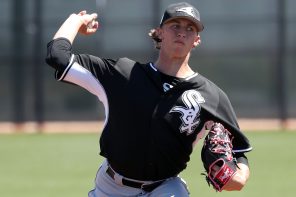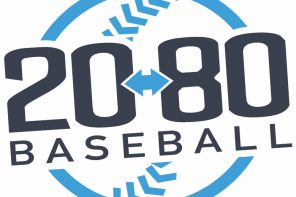Willie Calhoun
 |
|
After a breakout 2016 campaign that saw Calhoun hammer Double-A pitching to the tune of 27 home runs and a .218 ISO mark, the young second-sacker has taken a step forward in Triple-A this year and is showing that his power is very real. While short in stature, Calhoun has a thick, strong frame and extremely quick hands that help him to create excellent barrel exit and carry on his fly balls. He does tend to work underneath the ball, however and his extreme pull approach is something that will limit his upside going forward. Of his 14 long balls in 2017, all but one have been to right field, and his tendency to try and hook balls on the outer half has resulted in turning over weak ground balls to the right side as well as pop outs to the left side. While he does have the ability to shoot the ball the other way, he’ll need to prove he can do that more consistently, or risk being exposed by the better command that he’ll see in the big leagues, as well as the extreme shifts hitters with his profile will be defensed. That all said, Calhoun is more than a three-true-outcome type of player, as he has always made a lot of contact (career 11.5% K rate) and has shown some ability to get on base at the upper levels of the minors (.319 OBP in 2016 at Double-A and .343 OBP so far this year in 277 PA’s). Calhoun has also done a nice job versus lefties in 2017, hitting .298 with an .918 OPS over 57 at-bats – a significant improvement from the .219 average and .575 OPS he posted versus southpaws a year ago. So while the 22-year-old isn’t without his holes, he has shown improvement in key areas while stepping up to Triple-A. He is still without a position though, as he is a below-average defender at second base with limited arm strength and a below-average run tool. He has done better in 2017 to make the routine plays this year with only four errors in 65 games after 21 in 2016 – however the range is still a limiting factor because of the slow first-step-quickness, and that will make it hard to keep him in the infield in the big leagues. He has started to see some time in left field, but obviously the value declines a bit with the offensive profile becoming more pedestrian as a corner outfielder. Wherever he ends up defensively, the power bat is going to drive the profile – he has a chance to work his way into an everyday role if he can move away from the pull-centric approach that will otherwise leave big holes to pitch to. That, combined with the lack of defensive value, ultimately make it a high risk profile, with the most likely landing spot being in a platoon role at the major league level, in a role comparable to that of Matt Stairs (OF/1B, 1992-2011, multiple teams). |



